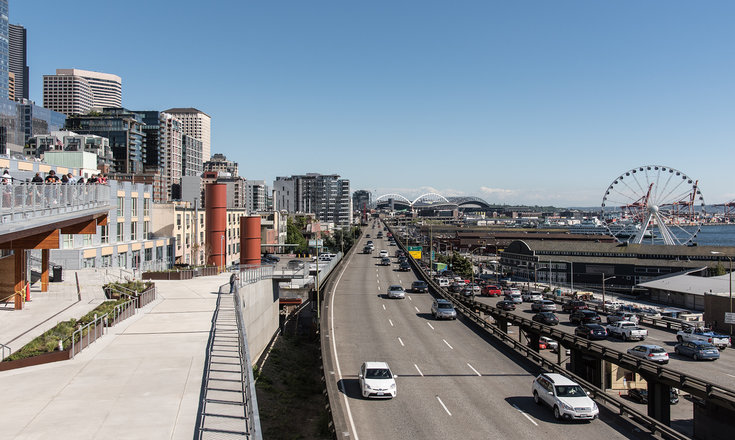The #seattlesqueeze is coming next week. Friday, January 4th, is when the first wave of traffic impacts will hit with the closure of on and off ramps to the viaduct near the stadiums, which is expected to affect traffic in the SoDo area significantly. Are you prepared for the changes to come over the next five years? That’s right, FIVE YEARS, not five or six weeks. The closure and subsequent removal of the Alaskan Way Viaduct, scheduled for January 11th, is just one major piece of the puzzle. The traffic revisions coming to Seattle also involve the removal of buses from the tunnels to allow for faster light-rail-only traffic, expansion of the Washington State Convention Center, renovations at Key Arena, light rail expansion, and the new Alaskan Way Waterfront. We’re heading into what is referred to as the Period of Maximum Constraint, which will hit the city’s traffic hard for approximately six weeks.
One of the most important things you can do during this time is to eliminate all solo car trips into or through downtown.
The closure of the viaduct doesn’t just impact the downtown area, as the entirety of SR99 will be closed from the West Seattle Bridge to the Battery Street Tunnel. Meaning all of the bus traffic usually on SR99 will be out on surface streets like 1st Ave S and 4th Ave S. One of the most important things you can do during this time is to eliminate all solo car trips into or through downtown. Driving downtown isn’t just impractical because of the additional traffic. Street parking in some parts of the central business district will be off limits during the squeeze to allow for extra travel lanes. Keeping your car off the road will help to keep things moving. And you thought street parking downtown was terrible before!
There are several new options for using public transit during the squeeze. Ride2, a service from King County Metro, will provide on-demand rides to and from Alaska Junction and the Seacrest Marina in West Seattle. You can use your Orca card to request a Ride2, and you’ll be able to transfer to buses or the Water Taxi. Water Taxi service will only take you about 10 minutes to get to downtown, and they’re adding one more sailing vessel. The downside to using the Water Taxi is the long walk in the cold Seattle winter from Coleman Dock to bus lines or the Pioneer Square Light Rail Station. They’re recommending not to use Uber or Lyft during this time, but it might be a good option if the weather isn’t cooperating. The rideshare companies are offering some fare discounts during the squeeze when getting rides to and from major public transit hubs outside of the downtown area.
Work with your instructors to see if they will provide any hybrid content or allow for reduced attendance during the project.
If you’re looking for more ways you can avoid traffic crunches, try changing your school and work schedule. It is highly advised to avoid travel during peak commute hours, so ask your boss about virtual meetings and working remotely. Work with your instructors to see if they will provide any hybrid content or allow for reduced attendance during the project. Some instructors have already planned for this, but unfortunately, it isn’t possible for all courses to be modified.
For more information on the upcoming #SeattleSqueeze, make sure to check out the video at the top of this post detailing the five-year plan the city has in place for traffic and transportation revisions. Remember, if you’re looking for accurate updates on real-time traffic conditions, you can find them here and even subscribe to daily email updates on your commute route. I tested the times out randomly over the past couple of weeks, and they’ve been spot-on.
Good luck to everyone commuting this winter quarter and try to look at the positives. Maybe more time on the bus means more time reading your textbooks…?
For a more comprehensive list of street and exit closures, bus reroutes, tips and tricks, go here: #realign99.






